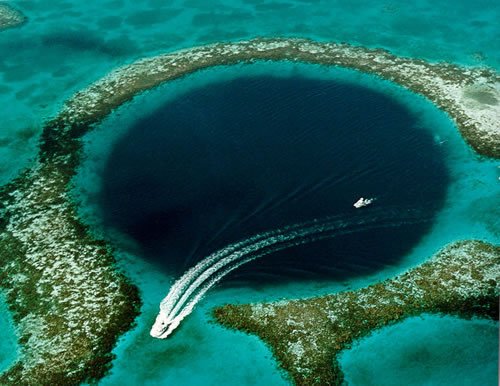A 30-meter sediment core drilled from the depths of the Great Blue Hole in the Caribbean has revealed a detailed archive of the region’s storm history, stretching back nearly 6,000 years. The findings suggest that while the Caribbean has long faced tropical storms, human-driven climate change could be intensifying storm activity at an unprecedented rate.
What Is the Great Blue Hole?
Located about 80 kilometers off the coast of Belize in the Lighthouse Reef Atoll, the Great Blue Hole is one of the largest marine sinkholes in the world. It spans 318 meters (1,043 feet) in diameter and plunges 124 meters (407 feet) deep. This massive, circular underwater formation began as a limestone cave system during the last glacial periods, when sea levels were lower. As the glaciers melted and sea levels rose, the caves were submerged and eventually collapsed, creating the sinkhole.
Drilling for the Past
In 2022, researchers from Goethe University Frankfurt conducted a scientific expedition to extract a 30-meter core sample from the hole’s oxygen-deprived bottom. Using a specially transported offshore drilling platform, the team obtained a sediment core rich in information about ancient weather patterns.
“Due to the unique environmental conditions – including oxygen-free bottom water and several stratified water layers – fine marine sediments could settle largely undisturbed in the ‘Great Blue Hole.’ Inside the sediment core, they look a bit like tree rings,” explained Dr. Dominik Schmitt, lead author and researcher at Goethe University’s Biosedimentology Research Group.
Signs of Past Storms
Researchers examined the core for tempestites – layers of coarse sediment deposited by storm surges – which stand out in color and composition compared to the regular fine layers. In total, they identified 574 distinct storm events in the past 5,700 years.
READ MORE: Australian Scientists Discover New Marine Life in Antarctica
“These tempestites stand out from the fair-weather gray-green sediments in terms of grain size, composition, and color, which ranges from beige to white,” added Schmitt.
An Increasing Trend
Perhaps the most alarming result is the apparent increase in storm frequency over time. According to the data, this region historically experienced four to sixteen storms per century. Yet, the past 20 years alone have seen nine major storms in the area.
“Our results suggest that some 45 tropical storms and hurricanes could pass over this region in our century alone. This would far exceed the natural variability of the past millennia,” said Professor Eberhard Gischler, head of the Biosedimentology Research Group.
Human-Driven Climate Change
The researchers believe the rise in storm activity cannot be explained solely by natural climate variability. They point to the southward shift of the Intertropical Convergence Zone—a key storm-forming weather belt—and warming sea temperatures as critical factors.
These trends, they argue, are exacerbated by anthropogenic climate change. Since the Industrial Age, human activity has increased greenhouse gas emissions, elevating ocean temperatures and contributing to more frequent and intense hurricanes.
Looking Ahead
This study not only provides a historical record of Caribbean storm activity but also serves as a warning. If trends continue, the region could see storm activity well beyond historical norms, with devastating implications for coastal communities and ecosystems.
